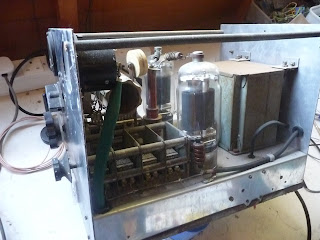 The specification and base pin out left is for an 813 Power Pentode in class C. Photos of my twin 813 amp are shown below.
The specification and base pin out left is for an 813 Power Pentode in class C. Photos of my twin 813 amp are shown below.
Its little brother amplifier shown is a 3 x 807 beam tetrode HF power amplifier which has evolved over the last couple of decades. In fact I'm pretty sure that one of the three 807 valves is out of my first transmitter, a No 19 set, purchased from G3WQN in 1970. Output power is about 150 watts on 160m, 80 and 40m.

The 813 linear is currently configured as per G2DAF design with step up and rectified input for the screen supply.
One pic shows the 813 beam power pentodes next to a 5u4 rectifier - for size comparison. Between 2kV and 2.5kV is needed on the anode and 400V for grid 2. The pentode construction gives very high gain and in class C (CW) 4 watts input should result in nearly 400W output (each). (ICAS conditions - not current bias cndx). So one in a box could be a nice add on to the FT 817ND.

.

Comments